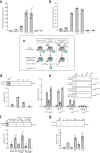Mycobacterial HelD connects RNA polymerase recycling with transcription initiation
- PMID: 39384756
- PMCID: PMC11464796
- DOI: 10.1038/s41467-024-52891-5
Mycobacterial HelD connects RNA polymerase recycling with transcription initiation
Abstract
Mycobacterial HelD is a transcription factor that recycles stalled RNAP by dissociating it from nucleic acids and, if present, from the antibiotic rifampicin. The rescued RNAP, however, must disengage from HelD to participate in subsequent rounds of transcription. The mechanism of release is unknown. We show that HelD from Mycobacterium smegmatis forms a complex with RNAP associated with the primary sigma factor σA and transcription factor RbpA but not CarD. We solve several structures of RNAP-σA-RbpA-HelD without and with promoter DNA. These snapshots capture HelD during transcription initiation, describing mechanistic aspects of HelD release from RNAP and its protective effect against rifampicin. Biochemical evidence supports these findings, defines the role of ATP binding and hydrolysis by HelD in the process, and confirms the rifampicin-protective effect of HelD. Collectively, these results show that when HelD is present during transcription initiation, the process is protected from rifampicin until the last possible moment.
© 2024. The Author(s).
Conflict of interest statement
The authors declare no competing interests.
Figures






References
Publication types
MeSH terms
Substances
Associated data
- Actions
- Actions
- Actions
- Actions
- Actions
- Actions
- Actions
- Actions
- Actions
- Actions
- Actions
- Actions
- Actions
- Actions
- Actions
- Actions
- Actions
LinkOut - more resources
Full Text Sources

